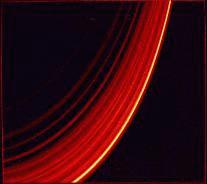|
|
 We
hypothesize that internal planetary oscillations produce rings. Probably only
the larger partly gaseous planets oscillate strongly enough to produce important
visible affects on surrounding matter. This time the oscillations, however, are
not the whole body oscillations that tend to place and control the planets of
the sun and the satellites of the large partly gaseous planets (see the article
Waves in
Dark Matter and the article Dark Matter Waves And Planetary Rings
). We hypothesize that these oscillations are due to oscillating
layers within the gaseous planets. These oscillations provide sharp edges for
most rings that gravity alone cannot provide. These oscillations are much different
in frequency and amplitude than the fundamental oscillation frequency of a planet.
These oscillations are likely considerably smaller in amplitude than that of the
fundamental and thus only first nodes away from the planet would be important
in forming rings. Rings would form rather than satellites because the non-fundamental
oscillations would not have a corresponding synchronized axial node associated
with their standing wave patterns. Wide rings would be present because of continuous
reflection across thick planetary layers. We have calculated some of the expected
thicknesses of some of these planetary layers from the width of planetary rings
in the article Dark Matter Waves And Planetary Rings
. The sharp cutoffs on the edges of some of the rings without shepherd
moons indicate that some planetary layer boundaries are quite sharp. Perhaps a
layer of ice would be a potential candidate to produce a wide ring. Ring structure
does not change because of continuing internal oscillations. Contrast this with
the location of satellites which may not be where they were placed because of
catastrophic events or changes in the size of a planet. See the article Dark Matter Waves And Planetary Rings
.
We
hypothesize that internal planetary oscillations produce rings. Probably only
the larger partly gaseous planets oscillate strongly enough to produce important
visible affects on surrounding matter. This time the oscillations, however, are
not the whole body oscillations that tend to place and control the planets of
the sun and the satellites of the large partly gaseous planets (see the article
Waves in
Dark Matter and the article Dark Matter Waves And Planetary Rings
). We hypothesize that these oscillations are due to oscillating
layers within the gaseous planets. These oscillations provide sharp edges for
most rings that gravity alone cannot provide. These oscillations are much different
in frequency and amplitude than the fundamental oscillation frequency of a planet.
These oscillations are likely considerably smaller in amplitude than that of the
fundamental and thus only first nodes away from the planet would be important
in forming rings. Rings would form rather than satellites because the non-fundamental
oscillations would not have a corresponding synchronized axial node associated
with their standing wave patterns. Wide rings would be present because of continuous
reflection across thick planetary layers. We have calculated some of the expected
thicknesses of some of these planetary layers from the width of planetary rings
in the article Dark Matter Waves And Planetary Rings
. The sharp cutoffs on the edges of some of the rings without shepherd
moons indicate that some planetary layer boundaries are quite sharp. Perhaps a
layer of ice would be a potential candidate to produce a wide ring. Ring structure
does not change because of continuing internal oscillations. Contrast this with
the location of satellites which may not be where they were placed because of
catastrophic events or changes in the size of a planet. See the article Dark Matter Waves And Planetary Rings
.
| Copyright ©1996-2018 Wagner Research Laboratory |